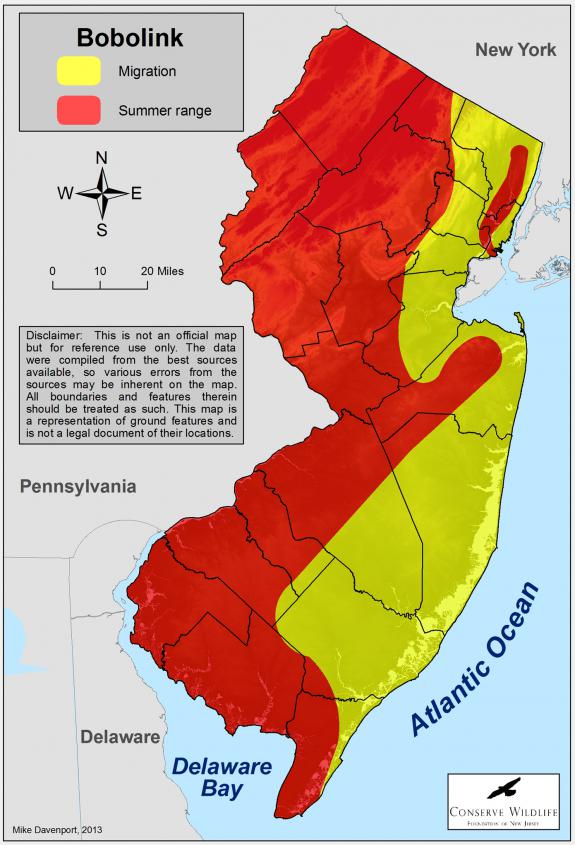Dolichonyx oryzivorus
Type: bird
Status: threatened
Species Guide
Bobolink
Dolichonyx oryzivorus
Species Type: bird
Conservation Status: threatened
Identification
The male bobolink is the only North American bird that is black underneath and white on back. It almost looks like it put its clothes on backwards. During the breeding season, the male is black overall with a creamy nape and hindneck, a white rump, and white scapulars. The female is a drab buff color with dark brown streaking on the back, sides, and rump. She also has dark stripes on the head. During the non-breeding season, males resemble females. Immature bobolinks are more yellow than females and lack streaking on the sides of their bodies. All ages and sexes have a short, pointed bill and pointed tail feathers.
Their call is highly unique, a bubbly “bobo-o-link” that sounds more like a video game than a bird. Many people compare it to the mechanical beeps of R2-D2 in Star Wars. Bobolinks are often heard before they are seen, calling from the grasslands in New Jersey and beyond.

Distribution & Habitat
Bobolinks breed in southern Canada and the northern United States, from the Atlantic Coast states south to West Virginia and west to Oregon and Washington. Bobolinks are long-distance migrants, traveling over 6,000 miles to their South American wintering grounds in Brazil and Argentina. This 12,000+ mile round-trip flight is one of the longest migrations by any North American passerine.
Breeding bobolinks occur in low-intensity agricultural habitats, such as hayfields and pastures, during the breeding season. They may also inhabit fallow fields and meadows of grasses, forbs, and wildflowers. Larger sized fields support higher densities of nesting pairs of bobolinks but bobolinks may nest in grasslands of 5 to 10 acres. In late June and early July, post-breeding bobolinks concentrate in freshwater and coastal marshes where they remain for several weeks to molt. From early August through late September, a second influx of migrating bobolinks occurs along the Atlantic and Delaware Bay coasts.
Diet
The diet of the bobolink varies seasonally, with individuals consuming both animals and plants during different times of the year. In the spring and summer, insects play a major part in their diet. They may supplement their diet with seeds. They feed their young invertebrates such as caterpillars, grasshoppers, wasps, beetles, ants, spiders, etc. At other times of the year, bobolinks eat primarily plant matter including rice, seeds, oats, grain, and corn.
Life Cycle
In early May, male bobolinks arrive on their breeding grounds, often.jpg’eturning to the same area year after year. Within a week, females arrive. Male bobolinks are territorial during the early breeding season. Bobolink nesting colonies bustle with mating activity – spirited courtship displays, lively songs, aerial chases, and vigorous competition for mates. If habitat conditions are favorable (ample space and enough food), male bobolinks may mate with several females. A female may pair with her mate from the previous year.
Once paired, the female plucks a small area of vegetation for her nest. The ground nest, which is located near a large clump of grass, is well camouflaged. Grasses and weeds are carefully woven together to form a cup nest, which is then lined with fine grasses. The female lays a clutch of 5 to 6 pale brown blotched eggs once a year, and she incubates them for 11 to 13 days.
After the chicks hatch, the male aids the female in brooding and feeding the young. Unable to fly, the chicks leave the nest at 10 to 14 days and hide in the thick vegetation. At about 16 days old, the young begin to fly, but the parents continue to feed them for another 4 weeks. Following fledging, family groups from several nests join together in flocks and soon depart from their breeding territories. They converge on marshes, where they remain for several weeks to molt and feed in preparation for their fall migration back to South America.
Current Threats, Status, and Conservation
Due to population declines and habitat loss, the bobolink was listed as a threatened species in New Jersey in 1979.
New Jersey loses a few thousand acres of farmland each year, and much of the remaining ground is farmed to the margins in order to be economically viable. Additionally, changing agricultural practices have played a major role in the decline of bobolinks in the Northeast. Hay fields are currently harvested earlier and more frequently than during historic times, often resulting in nest failure through direct mortality of eggs and nestlings or through nest abandonment following mowing. Bobolink chicks also experience increased vulnerability to predation in mowed fields due to the lack of cover.
Bobolinks also face threats on their South American wintering grounds. Farmers shoot bobolinks who view them as agricultural pests and they are also collected as pests. Additionally, many hazardous pesticides are used on foreign farm fields, particularly in areas where strict environmental laws are lacking.
Conservation and proper management of grasslands in New Jersey is critical to provide habitat for nesting bobolinks. Farmland preservation and cooperative efforts with landowners are critical to ensure proper habitat for breeding bobolinks. Quality habitat should be maintained, created, or restored.
Open habitats can be maintained either through mowing, grazing, or controlled burns. Mowing should be delayed until after the nesting season is completed (mid- to late July in New Jersey). Since 2005, Conserve Wildlife Foundation of New Jersey has worked with various partners and landowners to protect, manage, and create grasslands throughout the state.
Scientific Classification
- Kingdom: Animalia
- Phylum: Chordata
- Class: Aves
- Order: Passeriformes
- Family: Icteridae
- Genus: Dolichonyx
- Species: oryzivorus